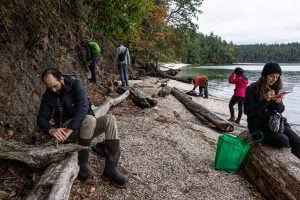
Environment
The sixth extinction
The planet is in the midst of drastic biodiversity loss that some experts think may be the next great species die-off. How did we get here and what can be done about it?
- 4895 words
- 20 minutes
This article is over 5 years old and may contain outdated information.
Wildlife

Each spring and fall, the rufa subspecies of red knot, a red-breasted shorebird scarcely larger than a robin, journeys up to 30,000 kilometres to and from the central Canadian Arctic and the southern tip of South America. Besides ubiquitous human development and climate change, the delicate balance between predator and prey is a principal threat. A population crash of 70 per cent between 1998 and 2007 is thought to be the result of overfishing of horseshoe crabs on the U.S. East Coast. About 25,000 rufa remain, a number that warrants endangered classification by the Committee on the Status of Endangered Species in Canada.

Late leavers
Southbound red knots depart the Canadian Arctic in three waves. Unsuccessful breeders leave in early July, along with females who’ve fledged a brood; their male counterparts depart in late July and early August; then the juveniles (with a few adult guides) take flight after mid-August. Canadian Wildlife Service biologist Yves Aubry says late migrants face two big threats: predatory migrating raptors and food shortages at fall stopovers. “That’s why the adults want to get out of the Arctic as soon as possible.”
Fuel shortage
Northbound red knots double their mass each spring during a two-week binge on horseshoe crabs around New Jersey’s Delaware Bay. The unregulated harvest of the crabs in the late 1990s, however, triggered the demise of rufa, says Allan Baker, the head of natural history at Toronto’s Royal Ontario Museum, who travels to Tierra del Fuego at the tip of South America each year to survey red knot populations. New Jersey subsequently outlawed the harvest in 2007. Baker says, “They’re just starting to come back, but it’s nothing like it was.”
The whims of weather
Poor spring weather can delay the birds’ arrival at their Delaware Bay feeding grounds, in turn cutting into breeding time in the short Arctic summer. Successful breeders and juveniles, meanwhile, are more likely to encounter tropical storms and hurricanes in September, something that can deplete their critical energy stores.
Red tide
Toxic algal blooms in the warm inshore waters of coastal Brazil and Uruguay — stopovers on the red knot’s northbound migratory path — are likely to blame for several observed die-offs, including 300 birds in 2007, says Allan Baker of the ROM.
Islands in the stream
About one-third of rufa stop at Quebec’s Mingan Archipelago National Park Reserve, in the Gulf of St. Lawrence. Here, expansive limestone tidal flats provide a cornucopia of snails, amphipods and blue mussels for hungry red knots, and there’s minimal human disturbance.
Mystery stops
Ornithologists such as the Royal Ontario Museum’s Mark Peck are using historical survey data and geolocators to identify and study lesser-known stopovers on the red knot migration route. Specifically, the extensive mudflats of Ontario’s James and Hudson bays appear to be key areas where shorebirds rest and feed on small clams and nematodes.
Are you passionate about Canadian geography?
You can support Canadian Geographic in 3 ways:

Environment
The planet is in the midst of drastic biodiversity loss that some experts think may be the next great species die-off. How did we get here and what can be done about it?

Wildlife
An estimated annual $175-billion business, the illegal trade in wildlife is the world’s fourth-largest criminal enterprise. It stands to radically alter the animal kingdom.

People & Culture
Naming leads to knowing, which leads to understanding. Residents of a small British Columbia island take to the forests and beaches to connect with their nonhuman neighbours

Wildlife
This past summer an ambitious wildlife under/overpass system broke ground in B.C. on a deadly stretch of highway just west of the Alberta border. Here’s how it happened.